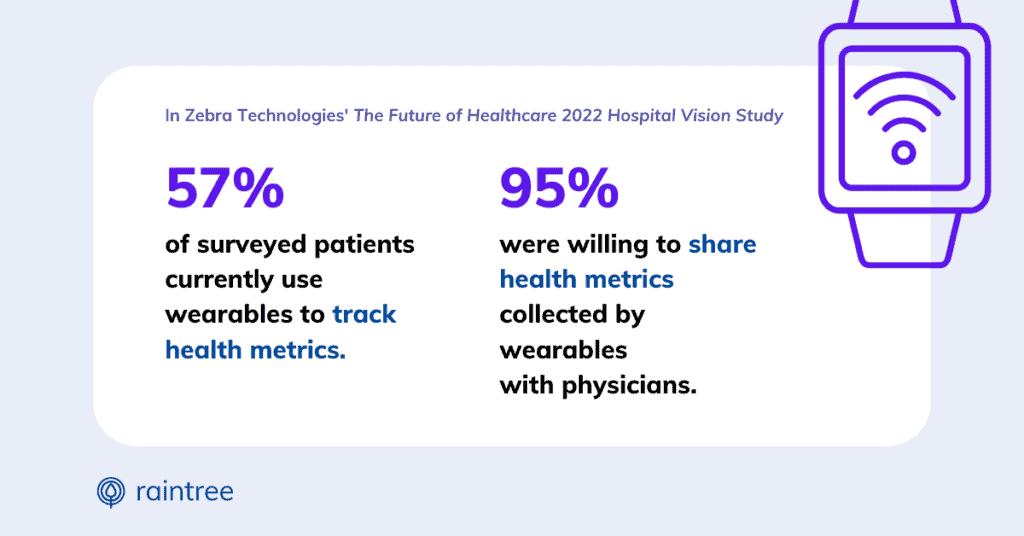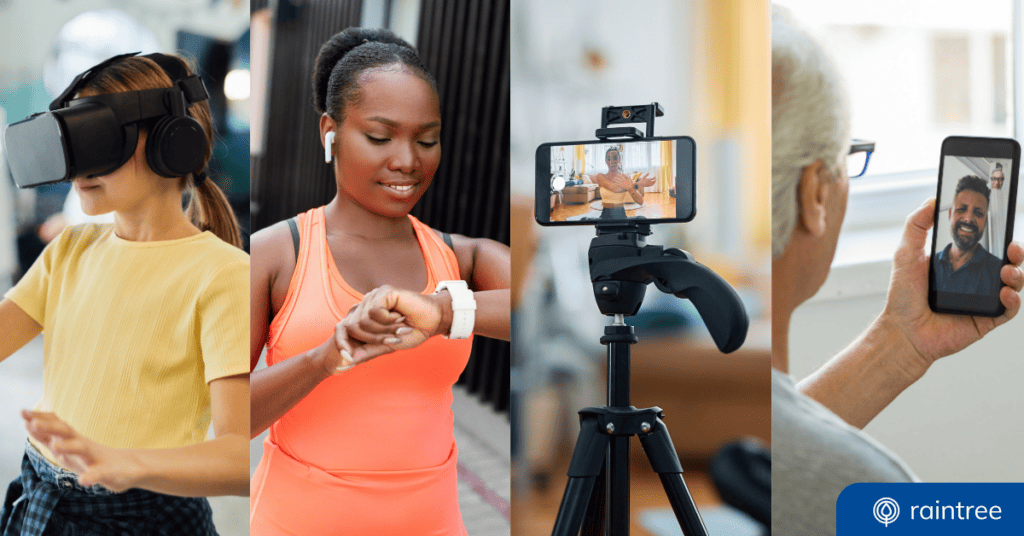Like much of healthcare, rehabilitation therapy is undergoing a transformation. Therapists are increasingly moving away from one-size-fits-all treatment plans to provide patient-centered care that meets the patient’s unique needs and goals. This broad shift is leading to changes like value-based care, home care, health tech interoperability, and more. At the same time, technological advances are hitting the market at warp speed.
So the question is: How can PTs use tech to advance the goals of their field of practice and provide better patient care?
The answer begins with taking a look at all the latest trends and emerging technologies in rehab therapy, from artificial intelligence to wearable technology, and beyond.
1. Artificial Intelligence
We’re coming in hot with the hottest topic of the year! According to a report from McKinsey & Company, artificial intelligence (AI) adoption has more than doubled since 2017. And it’s not slowing down! Early 2023 saw a massive expansion of public interest in AI, leading to projections that the sector will grow by 37.3% annually between 2023 and 2030.
Practically anyone who's ever heard of ChatGPT or Midjourney is asking one of two questions:
1. Will AI take my job?
2. How can I get AI to do my job?
In healthcare, there is a tremendous amount of opportunity for therapists to use AI to improve clinical efficiency and patient outcomes. Did you see that New York Times article about how AI is helping one stroke survivor regain the ability to speak? Years ago, we could only dreamed of this kind of assistive capability. But like any emerging technology, AI comes with its own risks.
Pros and Cons of AI in Rehab Therapy
There’s plenty to celebrate about the bloom of AI technology. For one thing, it has us all feeling creative. In many ways—and for good reason—the healthcare field resists disruption. But professionals in our field are quite the opposite. Clinical and non-clinical health workers want the same thing: To help patients achieve the impossible! So, naturally, we’re inclined toward innovation.
Possible applications of AI in rehab therapy include:
- Creating more comprehensive treatment planning protocols by factoring in patients’ health conditions and history.
- Analyzing posture and motion tracking data to identify if a patient is practicing an activity incorrectly.
- Transforming the landscape of healthcare marketing and patient engagement.
- Processing massive amounts of operational data to help practice executives make evidence-based decisions. (Oh, wait—we’re already doing this!)
Wait, what's the catch?
AI is a rapidly evolving sector, which means that we can’t assess the full scope of risks involved in its use. Over 50% of McKinsey survey respondents in 2023 cited inaccuracy and cybersecurity as risks of generative AI adoption, followed closely by intellectual property infringement.
It’s time to embrace the future, but the healthcare field must do it with a healthy dose of caution. As wise men say: “Only fools rush in.” (At least according to Elvis.)
2. Smart Home and Wearable Technology
Healthcare is increasingly moving beyond the walls of the typical hospital, clinic, or rehab facility setting. The concept of hospital-at-home first began in the 1990s, but the Covid-19 pandemic accelerated the shift. But how can therapists monitor patients’ progress if they aren’t being seen in a rehab facility? That’s where wearable technology comes in.
Wearables can be used in stroke rehabilitation as a way for rehab therapists to assess and monitor patients outside of a clinical setting. This allows them to gain valuable insights into progress, setbacks, and treatment adherence. But this technology isn’t limited to stroke rehabilitation. Wearable sensors can also enable “precision rehabilitation,” ensuring the patient gets the right intervention at the right time and in the right setting.

Wearables can be used in conjunction with smart home technology to improve independence and quality of life for people with disabilities and complex needs. Smart homes could enable health monitoring and allow healthcare providers or family members to check in on patients during rehab sessions.
Related Content:
3. Motion Capture Tech and Video Biofeedback
Motion capture technology is extremely common in the entertainment industry, but did you know it actually originated in healthcare? In the 1970s and 1980s, motion capture was used as a photogrammetric analysis tool in biomechanics research. Since then, its applications in medicine have evolved. Motion capture technology can analyze the movements of people who have mobility-limiting conditions, and physical therapists can use that data to make treatment recommendations. It also allows them to track adherence and patient progress—even remotely.
The great thing about motion capture technology is that it doesn’t have to be overly sophisticated. One systematic review found that more than 40% of studies used markerless motion capture (MMC) to assess patient populations. The Microsoft Kinect was the most frequently used MMC technology. It was used to estimate morphology, and studies found it was also accurate for measuring knee joint angle.
The review also found increased use of motion analysis using video captured by a smartphone camera. Studies in the review found that smartphone applications were reliable for measuring joint position and range of motion. More than 85% of Americans own a smartphone, making motion capture more widely accessible than ever before.
Motion capture can be combined with video biofeedback to allow physical therapists to visualize and quantify a patient’s progress in real time as they perform a rehabilitation exercise. The therapist can modify or correct the patient’s movement directly, even if they are not in the same place. These technologies can be used with traditional treatment modalities to provide even more insight into the patient’s progress.
4. Augmented and Virtual Reality
The market value for augmented reality (AR) and virtual reality (VR) in healthcare is projected to reach $9.7 billion in the next five years, according to a recent report by Research and Markets. One of the applications for AR and VR is in rehabilitation therapy, specifically in supporting patients with traumatic brain injuries (TBIs).
Research has found that VR advancements have the potential to improve the assessment and treatment of TBI, even when the patient’s chance of recovery seems poor. In one study, researchers created a virtual kitchen to assess daily-life activity and evaluate executive dysfunctions in patients with severe TBI. In another, researchers developed a VR avatar interaction platform to assess the residual executive functions in patients with mild TBI.
Using VR as a way to evaluate how the patient responds to a simulated environment can help therapists make adjustments to treatment plans by focusing on specific cognitive functions, such as memory or problem-solving. Not only that, but VR can also be used to help patients engage in interactive tasks that can help improve cognitive abilities.
Virtual reality can also support the home modification process in occupational therapy. The therapist can measure and evaluate factors such as room size, furniture, and door width and create floor plans that contain virtual pieces of durable medical equipment (DME). VR can also identify potential safety issues in the home environment before patients are discharged from the hospital.
5. Diagnostics Tools
Diagnostics tools can help rehab therapy providers set measurable goals from the ground up. Literally. Instrumented insoles show great promise as a diagnostic tool to analyze gait, for example. Instrumented insoles can provide real-time feedback so patients can make adjustments during the activity. They can also improve movement quality and increase lower limb loading, as well as improve patient adherence to weight-bearing restrictions.
Similarly, force plates can measure a patient’s center of pressure, helping therapists assess balance deficits or postural instability. These instabilities may be aftereffects of treatments of surgery, such as hip osteoarthritis surgery, or the result of a condition such as Parkinson’s disease, stroke, or diabetic neuropathy.
6. Video Game Technology
Gamification is another emerging trend in healthcare and in rehabilitation. In many video games, player characters become stronger and acquire new skills when they earn enough points to level up. The same principle can apply to treatment.
In physical therapy, gamification can be used to incentivize patients’ performance with level progression and point scoring when they make a correct movement. Following along with patient progress, the difficulty of challenges (or given tasks) could also increase with the patient’s level. Video game technology even has the exciting potential to combine with VR tech or wearables for a fully immersive experience!
7. Robotics for Rehabilitation
Robotics are common in industries such as manufacturing, but they also have several applications in healthcare.
One 2021 review in Healthcare (Basel) discussed the potential for assistive robotics to optimize and maximize the functionality of a limb. Robotics can also provide pain relief and improve trunk control, which is critical for preventing further injury.

Robotic and intelligent prosthetics, too, can improve the quality of life for patients with amputations. One study explored the potential for a regenerative peripheral nerve interface to produce amplified signals that turn into fine movements in a prosthetic. This gives the patient real-time control of the limb, allowing occupational therapy patients to regain fine motor skills like making a fist or picking up small objects, for example.
Similar to prostheses, exoskeleton technology can help provide support and assistance to a patient’s muscles and joints. If a patient has motor or functional impairments, an exoskeleton can help them with sit-to-stand and gait training. Exoskeleton tech today comes with technical limitations and a prohibitively high cost, but as the field progresses, we hope to see these challenges diminish.
8. Light-weighting and Unweighting Equipment
Weight-bearing can be very challenging for patients with musculoskeletal injuries or disabilities. These patients may need to be gradually introduced to bearing their limbs and body weight during exercise programs. Innovative technologies in unweighting help reduce risk of injury or falls during rehabilitation and physical therapy treatment.
Aquatic therapy is a great option, but not every clinic has the space or budget for an entire pool. Anti-gravity treadmills stand out among recent trends in medical tech, used to improve patient outcomes in walking and running injury recovery. These treadmills surround and support the lower half of the patient’s body to provide similar motion stimuli as running on the ground. By removing up to 80% of a patient’s body weight, the treadmill can minimize impact and prevents soft tissue injury.
9. Advanced Telehealth or Telerehabilitation
The Covid-19 quarantine period accelerated the use of telehealth and telerehabilitation, but it doesn’t show any signs of slowing down. As an alternative to face-to-face therapy, telerehabilitation creates greater access to care for patients with disabilities or a lack of transportation. Video visits can be used to provide real-time feedback, while patients receive necessary care from the comfort of home.
With the explosive adoption of telehealth, there are numerous platforms for rehab therapists to choose from. Therapists should look for a solution that can help them seamlessly shift from in-person visits. Raintree’s telehealth tools can help facilitate therapy and rehabilitation with comprehensive options that provide continuity of care for patients who need to transition to digital therapy.
10. Business Intelligence and Analytics Tools
Business intelligence originated in the financial sector, but its applications have since expanded to healthcare and other industries. These tools are valuable not only in clinical decision-making, but also in practice management, marketing, and patient engagement.
In the context of rehabilitation therapy, for example, Raintree’s business intelligence software leverages key financial, operational, and clinical metrics that help you recognize main problem areas, track data trends as well as make data-driven decisions.
11. Upgraded Patient Engagement Platforms
As consumers, patients expect convenience. They’re able to order a ride or have groceries delivered with the click of a button, and they can bank from an app. So why wouldn’t they expect the same experience in healthcare?
Patient engagement platforms make it easier for patients to engage with your practice and with their own health information. For example, patients can use their portals to book a new appointment, check-in or reschedule, access their care instructions or HEPs, track progress, or view test results.
One of the most important aspects of a patient engagement platform is user-friendliness. Raintree Connect makes it easier for therapy practices to provide a seamless experience for patients. Our comprehensive patient engagement suite allows providers to personalize the patient experience while growing alongside them throughout their journey.
12. PT Practice Management Software
Too many practices, including physical therapy practices, rely on outdated manual methods for practice management. Not only do these processes come with a risk of error, but they’re also time-consuming and can contribute to provider burnout.
Efficient practice management software allows providers to streamline workflows, improve communication between systems, and much more. Practices should look for systems that are scalable and continuous, meaning they can grow alongside the practice as it sees more patients. For example, Raintree’s award-winning all-in-one therapy and rehab platform sets the bar for configurability, compliance, and convenience.
Implementing New Technologies in Your Practice
Are you fired up about all the possibilities of these advancements in technology? Us too. Don’t let that energy go! Before you leave, let’s ask:
- How can these tools be implemented in your practice?
- Which, if any, of these tools are you already using, and how can you maximize their potential?
- What does the future of rehab therapy hold?
As a leading provider of rehab therapy software, Raintree is dedicated to the process of continuous improvement and innovation. Experience the future of rehab therapy.



